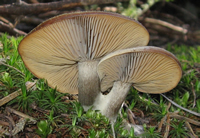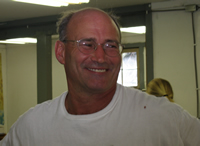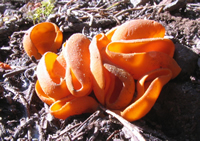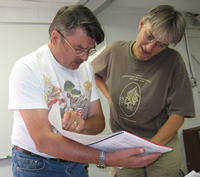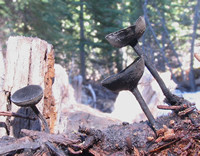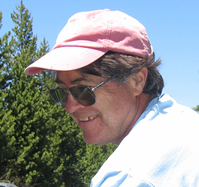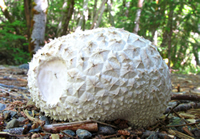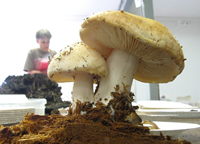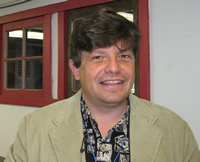BAMS Inaugural Foray - Yuba Pass
June 15-17, 2006
BAMS members had both a literal and a figurative hot time this past weekend, in the mountains around Yuba Pass. On the heels of our latest Bay Area cold snap, the mountain temperatures were surprisingly warm, and the remaining snowbanks, after the endless snows of this winter and spring, were rapidly melting. A number of mushrooms were already well-dried in the field, but there were plenty of fresh ones to tempt our eye and challenge our ID skills.
During our trip up on Friday, keen-eyed Sandi Smith found our first edible: a pure, white Calbovista subsculpta, one of the mountain puffballs. Later that morning, poking in the pine duff, we found several, slightly chewed Boletus pinophilus, and some beautiful clusters of electric-yellow, probably toxic Amanita aprica (Arora's "Sierran gemmata").
Stopping briefly at the SFSU Sierra Nevada Field Station, Hugh Smith crawled under his tent-cabin platform and located two "dried on the stem" morels; they were the only ones found this weekend. That's thinking (and searching) outside of the box, Hugh!
Later that same afternoon, a group of us combed a famous (for mushroomers, at least) local bog, and discovered large fruitings of two water-dwelling mushrooms: Mitrula elegans, or the "swamp beacon", and Sclerotinia veratri, a stalked, brown, cup fungus that grows from a sclerotium. One particularly nice cluster of Sclerotinia had its cups sticking up from a raft of green slime, floating on the surface of the water. Just another special, fungal moment.
Else Vellinga happily hunted the bog, and pointed out the beautiful, green rein orchids that grew upon the sodden ground; their flattened, elongated lower flower buds looked to me like a duck's bill.
In the same area, on a slightly elevated, mossy knoll, Sandi spied a tiny, white mycena, and I mean tiny; the colorless mushroom, was not more that a few millimeters tall. Even though it was thinner than a human hair when it dried-up, it still keyed out nicely; the size, color, habitat, and white, cushiony base of the stem gave me my best, and most unexpected ID: Mycena adscendens.
Friday night, early foray arrivals shared a yummy potluck dinner at Chapman Creek campground, a quick, pre-dark swamp stomp (where I found a pretty, purple cort) and later, a lovely fire; but we sure didn't need that fire to keep warm. Thank heavens, purely as an afterthought, I packed teeshirts and shorts along with my wool sweaters; it was T-shirt weather for sure, even after dark.
On Saturday morning, after a yummy breakfast of crepes, and fresh fruit, and bacon (Mmmmmmmmm, bacon), we headed out into the field. Our first stop was just East of the Field Station, along Hwy. 49 and the Yuba River, in a mixed pine/fir/cedar forest; there were intermittent patches of snow. During my scouting mission there the day before, everywhere I looked, in every hollow and cranny, there was a little bit of fungal/botanical/ insectoid/ mineraloid growth. And everything still just slightly damp, slightly springy underfoot.
As we wandered through the forest, I wished for the services of the "Mistress of Clitocybes", Denise Gregory, 'cause paleish, brownish, tannish clitocybes were everywhere. Caloscypha fulgens, a small to medium, pretty orange asco, was scattered across the ground; this particular population lacked the more familiar, greenish outer surface of the cup. The cryptic Cryptoporus, still fresh enough to be slightly spongy, and some colored a beautiful varnished fawn, hung from the trees and downed logs; handfulls were scattered across the ground.
Heterotextus alpinus, a brilliant orange, flattened, cone-shaped, stalked jelly, punctuated the pine forest. They were hanging, down and up, on rotten wood, at the edges of the snowbanks. Also abundant on wood was the secotioid fungus Nivagastrium nubigastrum, a pholiota that is (d)evolving towards an underground life, and smells like chemical bubblegum. The squat fruit bodies, with short stalks, and gills that never fully open, look like upside-down pumpkins.
One of the prettiest of the snowbank mycenas was out in abundance; Mycena griseoveridis, with its yellow gills and multi-colored stipe, provided an easy ID. Another easily identified mycena, collected in lesser numbers, was M. overholdtzii, a large, gray species with an extraordinarily fuzzy "foot"; this species also grows on wood at snowmelt.
While breaking for lunch at Yuba Pass, we were pleased to have Bolek Kusnik appear and join our group, and even more delighted to see his prize find: Weraroa cucullata, a rarely collected, secotioid psilocybe. Wow, man, great 'shroom.
Despite the recent rains and mostly wet soil, our stops later in the day were not as productive. We went as high as we could, up to snowline, but had little to show for it. We appeared to be in the midst of a second fruiting for the season and area, judging from the dried, and/or rotten specimens found alongside the fresh. But even a dried mushroom gives you clues as to its ID, and sharpens your game.
A "dried in the field" mushroom dramatically showed the typical agaricus feature of free gills, with a pale, bald ring around its stipe, contrasting with the dark, chocolate brown gills, and hints to its species with a tell-tale yellow staining on the cap and stem. Those features were also present on a fresh and beautiful, sweet smelling, still partial-veiled and pale-gilled, Agaricus albolutescens; it was also yellowing, and at this stage, delicious.
Although we had to work hard for our fungi (and at elevation, it's always a little bit harder), we still managed to find piles of good stuff, and by Saturday afternoon our fine group of IDers were hard at work. In our gloomy basement lab, Dr. Else Vellinga and Phil Carpenter puzzled over the Tricholomas (among other, tricky 'shrooms); Henry Young hardly looked up from his scope, except to grin and grab another specimen; Dimitar Bojantchev impressed us all with his diligence, and burgeoning mycological library; John and Herman Brown (no relation) put some quality microscope time in, and even David and I managed to put a few names to things (see above).
The rest of our group, Hugh and Sandi, Eva and Cecilia, enjoyed the fine weather, location, and company, and left the mycological nitpicking to those that enjoy that sort of thing. We all enjoyed our walks through the glorious woods, and we look forward to seeing Hugh's and Herman's digital chronicles of mushrooms and mushroomers.
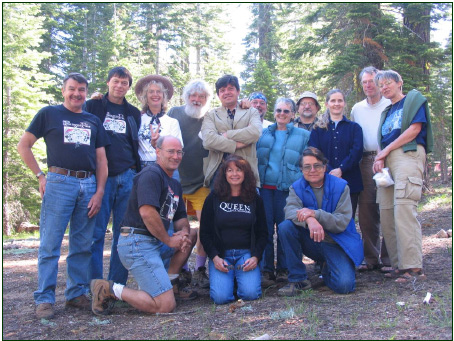
© photo by Hugh Smith
Sunday morning, I convinced some of the participants to drive with me out to the Sierraville marsh, a prime spot to view spectacular birdlife. Our BAMS members were good sports and peered at the birds, but the mushrooms called more loudly. So we (I) dragged ourselves away, to do a last hunt for pinophilus, before the long drive home.
What a fun, fungal weekend. And thanks for humoring me, guys, on that marsh detour; if it makes you feel any better, I make my poor birding friends look at mushrooms, too!
Debbie Viess
BAMS would like to say a special thank you to Sierra Nevada Field Station Director Jim Steele for providing laboratory space for us to set up microscopes.

